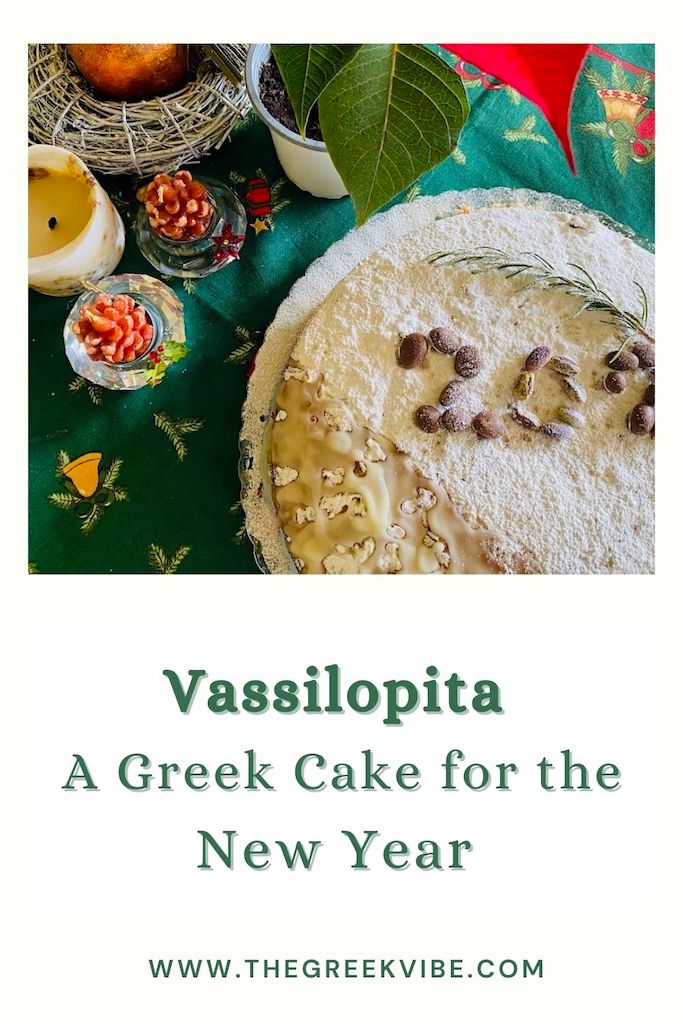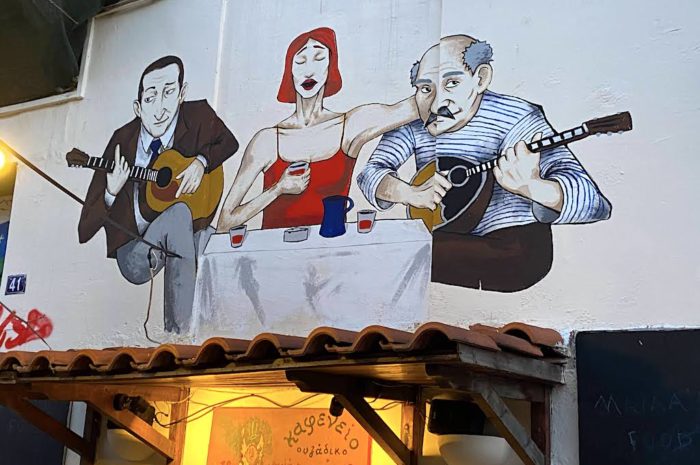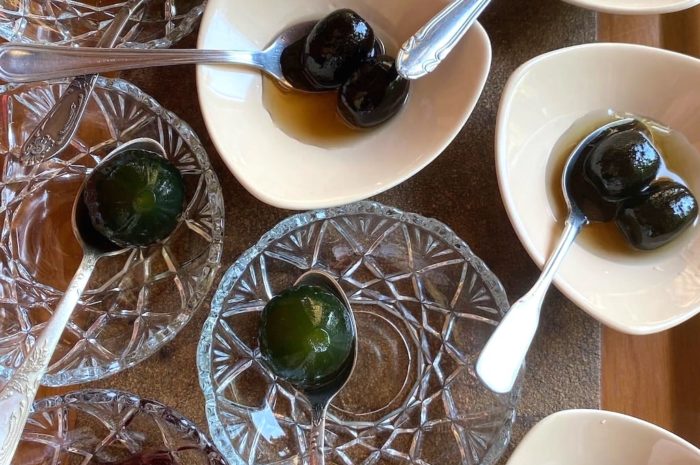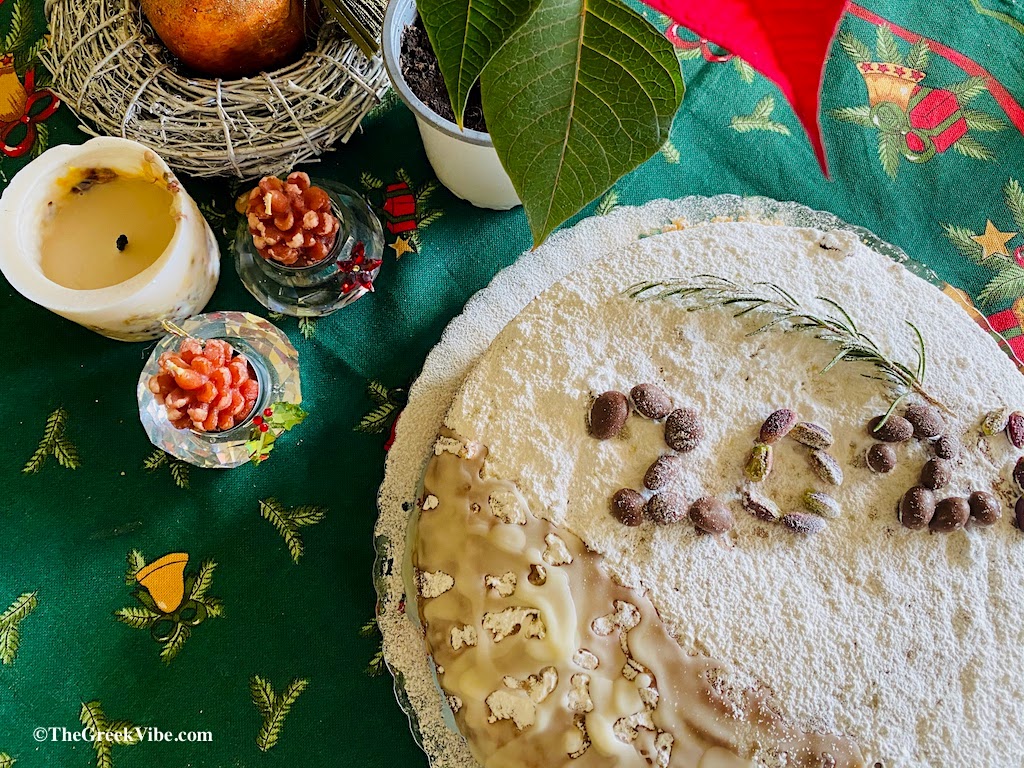
A cake, a coin and a new year full of luck: that basically sums up what the Greek vassilopita (or vasilopita) tradition is all about. And admittedly, it also best describes what all of us look forward to when the clock strikes midnight and a new year dawns.
The vassilopita is a cake made in Greek households to mark the beginning of a new year. But this cake is not your usual coffee-dipping variety. This cake is special because it carries blessings for a fortunate year and endless luck for that one person who happens to find the lucky coin.
The word “vassilopita” means “pie of kings”. And it is true! King (or Queen) is the person who finds the lucky “flouri” coin in his piece.
►Greece’s Fanouropita: A Cake to Help you Find Lost Items?
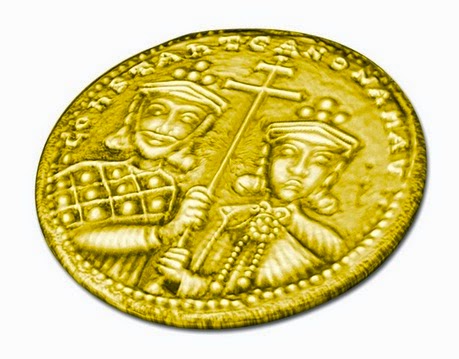
I Found the ‘Flouri’!
According to the custom, whoever finds the “flouri” coin is entitled to a full year of good luck, creativity and productivity. Besides the “flouri”, there are many Christmas and New Year’s traditions in Greece which bring fortune including the pomegranate and the onion, among others, which are also mentioned in the New Year’s kalanta (carols).
►Greek Carols for the New Year – The Kalanta Tradition
In the past, the flouri was a “Konstantinato” – a gold coin dating back to Byzantium with the image of St Constantine on it believed to fend off misfortune and guarantee fertile soil and divine protection. The “Konstantinato” was baked inside the family bread. That’s why the finder of the unique gift would place it in the “eikonostasi” (the “station with the icons”). Most Greek homes still have an “eikonostasi” where all sorts of religious icons are placed to protect the house. You could say that it’s makeshift altar of sorts where people go to pray and seek guidance.
To this day, the Konstantinato coin is always linked to luck, miracles, health, and healing and is kept as a precious heirloom.
Besides the valuable Konstantinato which is rare to find, for today’s vassilopita Greeks use “gouria” or “fylachta” (lucky charms) sold in gift shops. But you could always simply use a one-euro coin which you then keep for good luck in your wallet.
Each Greek Region & its Own Vassilopita
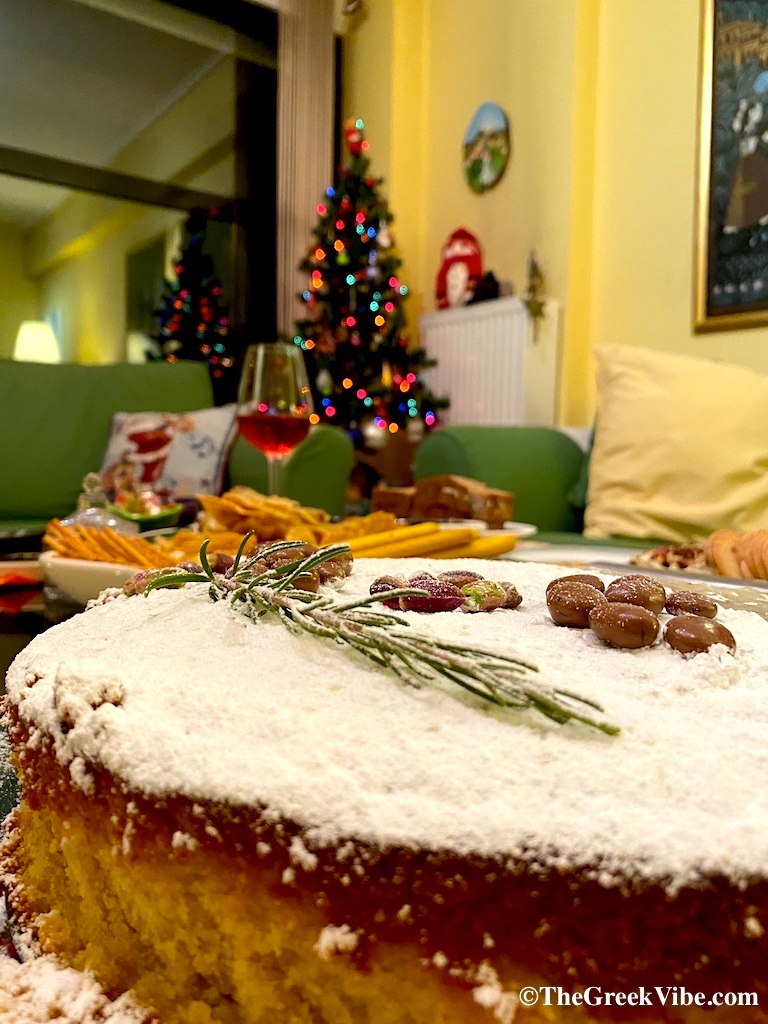
True to local traditions, each region in Greece is proud of its own vassilopita recipe which may be either sweet or savory, like a coffee cake or more of a brioche-style sweet bread and may include special designs, some dating back to the Byzantine era.
On the Greek islands, for instance, you’ll find all types of vassilopites some made using traditional phyllo pastry in the shape of a round “koulouri” or with a halva-like texture.
There are vassilopites made with cheese and phyllo like those in the Siatista region, or with meat in the Epirus region – a tradition of the Vlachs and Sarakatsani which were nomadic tribes. The Metsovo variety of vassilopita is made of mincemeat with the coin carefully inserted in the phyllo dough. In Ioannina, famed for its pites (pies), the New Year’s vassilopita is more of a shepherd’s pie made with meat and eggs. The importance of farming and livestock features in the vassilopites of Skyros and Karpathos islands where they made New Year’s pies for their farm animals: the “vouopita” or “vodokloura”, or for the shepherds who cared for them.
►Epiphany: When Greece Turns to Water & Light to Mark a New Start
Greek Vassilopita Sharing: The Rules
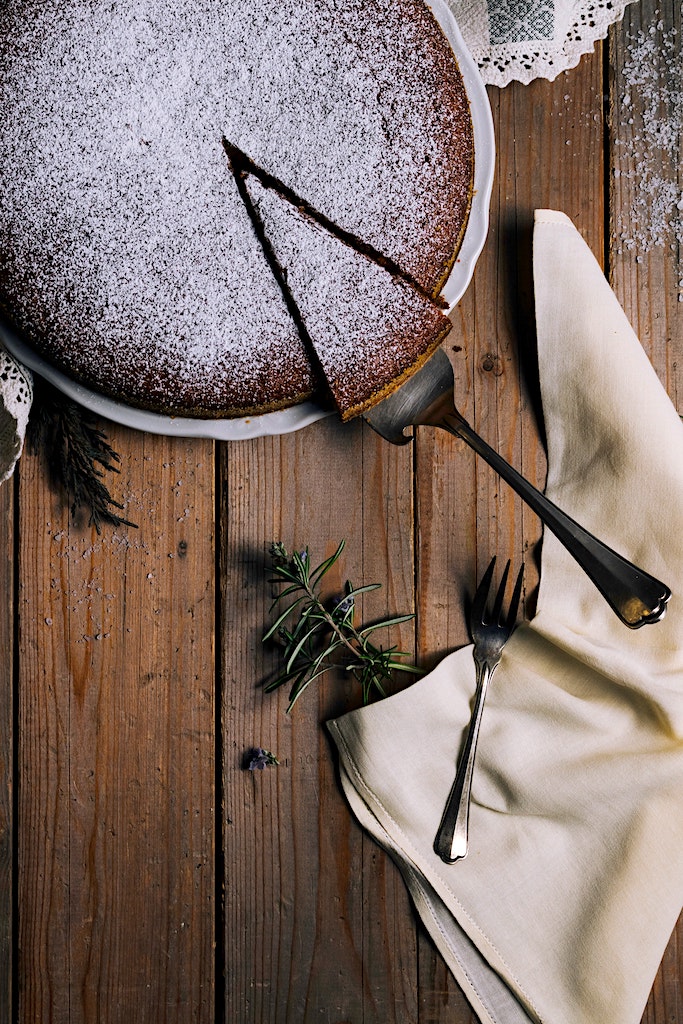
The vassilopita tradition is cherished and observed wherever there are Greeks. It is perhaps second in importance to the midnight Anastasi ritual on Easter.
On New Year’s Eve, family and friends gather around the lavishly decorated table. When I was young, New Year’s Eve was all about sitting at the table for hours after a long and sumptuous feast. The TV would be turned on as we waited for midnight. At 00.00 hours, my father would switch off all the lights and a minute later in a roar of joy we would all stand up and kiss each other (yes, Big Fat Greek Wedding-style) wishing “Hronia Polla” and “Kali Hronia” (Happy New Year).
Our family tradition has it that just after midnight, we all assemble around the family table and the vassilopita cutting ceremony begins. The head of the family, in this case my father, would “cross” the pita – make a sign of the cross three times using the knife – count how many people were present (or people to be included), express thankfulness (pretty much like Thanksgiving), and then begin to dutifully slice the pieces. Before slicing he would announce the name of the person who would be receiving the piece of the vassilopita cake on a red napkin.
►What Do Greeks Do on New Year’s
The rough sequence of vassilopita distribution starts with Christ, the Virgin Mary, Agios Vassilis (Saint Basil), home, and then from older to younger the members of the family. We of course always sliced pieces for our beloved pets as they too were precious members of the family and in Greek island homes, vassilopita pieces are kept for the sailors and seamen. Many families in the past would also slice a piece for the poor (“tou ftohou”).
► Basil: King of Greek Herbs & Culture
Lately, and depending on each individual family tradition, the vassilopita may also be cut on the morning of the first day of the new year (instead of midnight) – and it’s a wonderful way to start the new year afresh with coffee!
I should also add that Greek companies and businesses large and small all dedicate a day in the first few months of the new year to the vassilopita cutting for a productive and lucrative year, with slices (and the “flouri”) going to employees and the enterprise. The winner of the “flouri” can usually win anything from a weekend trip for two, a restaurant dinner, or even a day off!
Vassilopita Design
There a hundreds of recipes for vassilopita and each family insists their own is the best. Whether you choose to make a savory or sweet pie, you must make sure to insert a coin into the cake (preferably after baking so it doesn’t sink to the bottom) and design your cake with the new year on top. You could do this using almonds and sugar or be creative and use your favorite candies. I for instance have used everything from M&Ms and chocolate to peanuts and dates.
Check out this recipe for a healthier version of the Greek vassilopita.
►Greek Carols for the New Year – The Kalanta Tradition
The Vassilopita: The Story
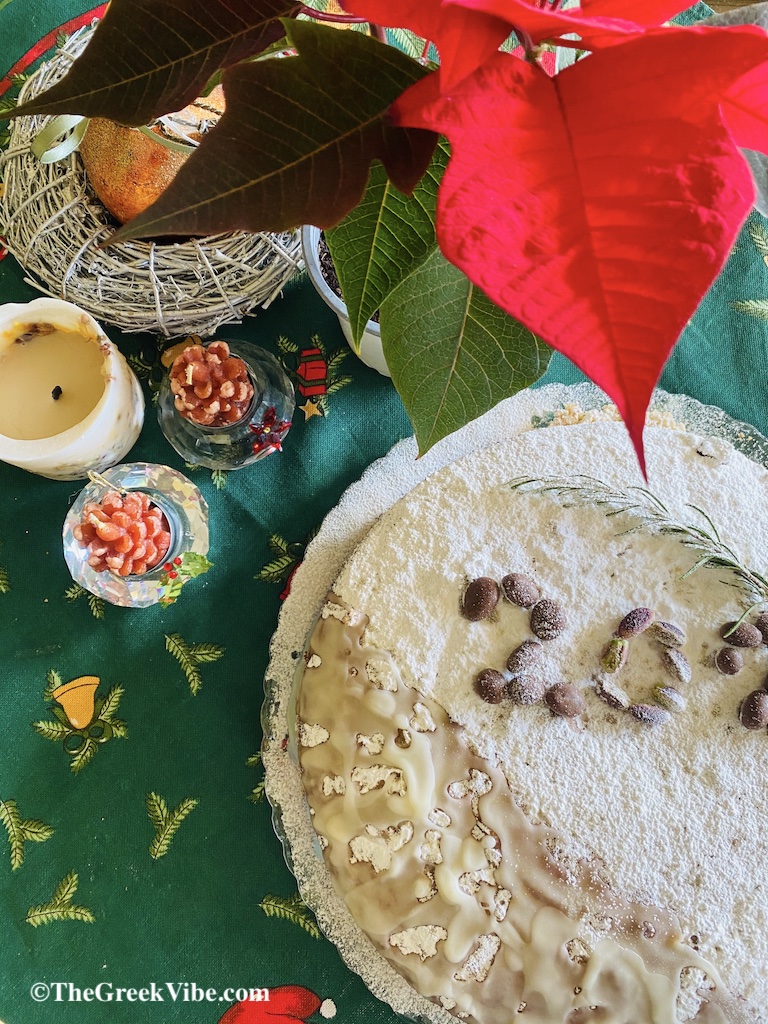
Legend has it that the vassilopita tradition dates back to Roman times and to the Saturnalia festival held in December as a tribute to the god Saturn. In Greece, the event was called “Kronia”, an Athens festival held in honor of Kronos (Saturn). The ancient Greeks very often decorated sweet breads which they offered to the gods. It is believed that the Francs were the first to actually place a coin inside the bread and declare the winner as king of the night.
In Greece, the vassilopita as well as the “kalanta” – the special New Year’s carols – tell the story of Agios Vassilios (Saint Basil), a bishop who lived in Cappadocia, Asia Minor in 330-378 AD.
The story has it that in efforts to save his town Caesarea from extreme taxes and punishment, Saint Basil called on the villagers to hand in their valuables. Somehow the city was salvaged before they handed over their treasures. A miracle? Who knows, and so Agios Vassilios thought of a fair way to return the riches. He asked the town’s bakers to make breads and place the items inside and then to distribute these to the villagers at church the next day. Agios Vassilios was renowned for his charity work. He died in 378 AD and was laid to rest on the first day of 379 AD. To mark his memory, a cake was made on January 1 each year with a coin. That is also why until the mid-1980s, Greeks would exchange and open gifts on New Year’s Day and not on Christmas.
🎶 I end today’s post with one of the many New Year’s “kalanta” (carols) from the island of Chios. Greek singer Pandelis Thalassinos sings of wishes for the safety of the home and the seamen, love, peace, health, a warm heart, smiles and divine blessings.
Enjoy and Happy New Year (Kali Hronia) to all!
